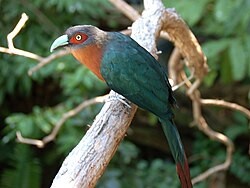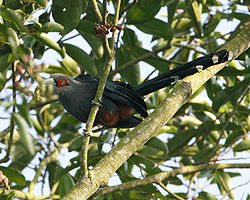| Common name | Scientific name and subspecies | Range | IUCN status and estimated population |
|---|
| Chestnut-breasted malkoha  | Phaenicophaeus curvirostris
(Shaw, 1810)
- P. c. singularis
- P. c. curvirostris
- P. c. deningeri
- P. c. microrhinus
- P. c. harringtoni
| Southeast Asia from Myanmar through to eastern Java, the Philippines and Borneo | LC
|
|---|
| Mentawai malkoha
| Phaenicophaeus oeneicaudus
Verreaux, J & Verreaux, É, 1855 | Mentawai Islands off the western coast of Sumatra | LC
|
|---|
| Black-bellied malkoha
| Phaenicophaeus diardi
(Lesson, 1830) | Brunei, Indonesia, Malaysia, Myanmar, Singapore, and Thailand. | LC
|
|---|
| Chestnut-bellied malkoha  | Phaenicophaeus sumatranus
(Raffles, 1822) | Brunei, Indonesia, Malaysia, Myanmar, Singapore, and Thailand. | LC
|
|---|
| Blue-faced malkoha  | Phaenicophaeus viridirostris
(Jerdon, 1840) | peninsular India and Sri Lanka. | LC
|
|---|
| Green-billed malkoha  | Phaenicophaeus tristis
(Lesson, 1830) | Indian Subcontinent and Southeast Asia | LC
|
|---|
| Red-faced malkoha  | Phaenicophaeus pyrrhocephalus
(Pennant, 1769) | Sri Lanka
 | LC
|
|---|








